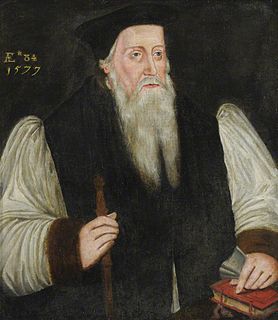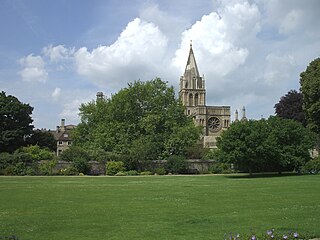Related Research Articles

Cuthbert Tunstall was an English Scholastic, church leader, diplomat, administrator and royal adviser. He served as Prince-Bishop of Durham during the reigns of Henry VIII, Edward VI, Mary I and Elizabeth I.
John Taylor was Master of the Rolls of the Court of Chancery from 1527 to 1534, following a successful career as a priest and civil servant.

Richard Cox was an English clergyman, who was Dean of Westminster and Bishop of Ely.
Thomas Thirlby, was the first and only bishop of Westminster (1540–50), and afterwards successively bishop of Norwich (1550–54) and bishop of Ely (1554–59). While he acquiesced in the Henrician schism, with its rejection in principle of the Roman papacy, he remained otherwise loyal to the doctrine of the Roman Catholic Church during the English Reformation.
Owen Oglethorpe was an English academic and Roman Catholic Bishop of Carlisle, 1557–1559.

Robert Ferrar was a Bishop of St David's in Wales.
John Scory was an English Dominican friar who later became a bishop in the Church of England.

Robert Reid was Abbot of Kinloss, Commendator-prior of Beauly, and Bishop of Orkney. He was born at Aikenhead in Clackmannan parish, the son of John Reid and Elizabeth Schanwell. His formal education began in 1511 at St Salvator's College in St Andrews University under the supervision of his uncle, Robert Schanwell, dean of the faculty of arts. Reid graduated in 1515 and by 1524 was subdean at Elgin Cathedral where, by 1527, he was Official of Moray. Thomas Chrystall, the abbot of Kinloss, chose Reid as his successor in 1526. In 1527, as abbot-designate, he attended the court of Pope Clement VII on abbacy business. While returning via Paris in 1528, Reid met the Piedmontese humanist scholar Giovanni Ferrerio who accompanied him back to Scotland. Following Chrystall's resignation in July 1528, Reid was blessed as abbot in September and received the Priory of Beauly, in commendam, in 1531. In that same year, Ferrerio left the court of James V to join Reid at Kinloss as tutor to the monks of both Kinloss and Beauly. Reid held many offices of state between 1532 and 1542 including ambassadorial roles to England and France and as a senior law official. He considerably improved the external and internal fabric of both monasteries in 1538.
Walter Haddon LL.D. (1515–1572) was an English civil lawyer, much involved in church and university affairs under Edward VI, Queen Mary, and Elizabeth I. He was a University of Cambridge humanist and reformer, and was highly reputed in his time as a Latinist. He sat as an MP during the reigns of Mary and Elizabeth. His controversial exchange with the Portuguese historian Jerónimo Osório attracted international attention partly on account of the scholarly reputations of the protagonists.

The Dean of Christ Church is the dean of Christ Church Cathedral, Oxford and head of the governing body of Christ Church, a constituent college of the University of Oxford. The cathedral is the mother church of the Church of England Diocese of Oxford and seat of the Bishop of Oxford. The chapter of canons of the cathedral has formed the governing body of the college since its foundation, with the dean as ex officio head of the chapter and ipso facto head of the college. Since 26 April 2022, the position has been vacant.
Richard Layton (1500?–1544) was an English churchman, jurist and diplomat, dean of York and a principal agent of Henry VIII and Thomas Cromwell in the Dissolution of the Monasteries.
Dr Richard Gwent was a senior ecclesiastical jurist, pluralist cleric and administrator through the period of the Dissolution of the Monasteries under Henry VIII. Of south Welsh origins, as a Doctor of both laws in the University of Oxford he rose swiftly to become Dean of the Arches and Archdeacon of London and of Brecon, and later of Huntingdon. He became an important figure in the operations of Thomas Cromwell, was a witness to Thomas Cranmer's private protestation on becoming Archbishop of Canterbury, and was Cranmer's Commissary and legal draftsman. He was an advocate on behalf of Katherine of Aragon in the proceedings against her, and helped to deliver the decree of annulment against Anne of Cleves.

Thomas Yale (1525/6–1577) was the Chancellor, Vicar general and Official Principal of the Head of the Church of England : Matthew Parker, 1st Archbishop of Canterbury and later on, of Edmund Grindal, 2nd Archbishop of Canterbury during the Elizabethan Religious Settlement. He was also Dean of the Arches, and High Commissioner to Queen Elizabeth Tudor at the Court of High Commission. .
Joseph Phillimore (1775–1855) was an English civil lawyer and politician, Regius Professor of Civil Law at Oxford from 1809.
Bartholomew Traheron (1510?–1558?) was an English Protestant writer and Marian exile.
Simon Haynes or Heynes was Dean of Exeter between 1537 and 1552.
Richard Woleman or Wolman was an English churchman, Archdeacon of Sudbury from 1522; and the Dean of Wells between 1529 and 1537.
William Benet was an English ambassador.
William Cliffe, Clyffe or Clyff was an English churchman and lawyer, dean of Chester from 1547.

John Gabriel Tęczyński Chamberlain (1515) and voivode of Sandomierz (1543), Castellan (1518) and the governor of Lublin, the Speaker of the court of the Crown (1522), Castellan of Wojnicki (1535), Count of the Holy Roman Empire (1527).
References
 This article incorporates text from a publication now in the public domain : "Oliver, John (d.1552)". Dictionary of National Biography . London: Smith, Elder & Co. 1885–1900.
This article incorporates text from a publication now in the public domain : "Oliver, John (d.1552)". Dictionary of National Biography . London: Smith, Elder & Co. 1885–1900.